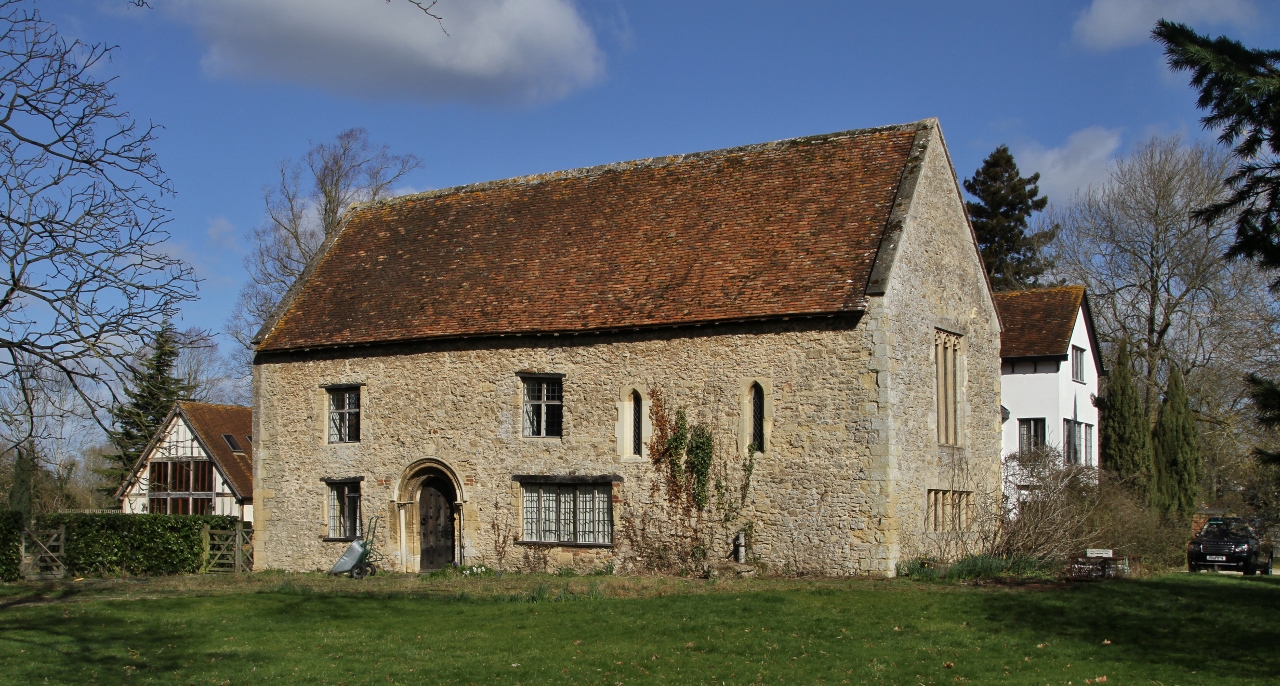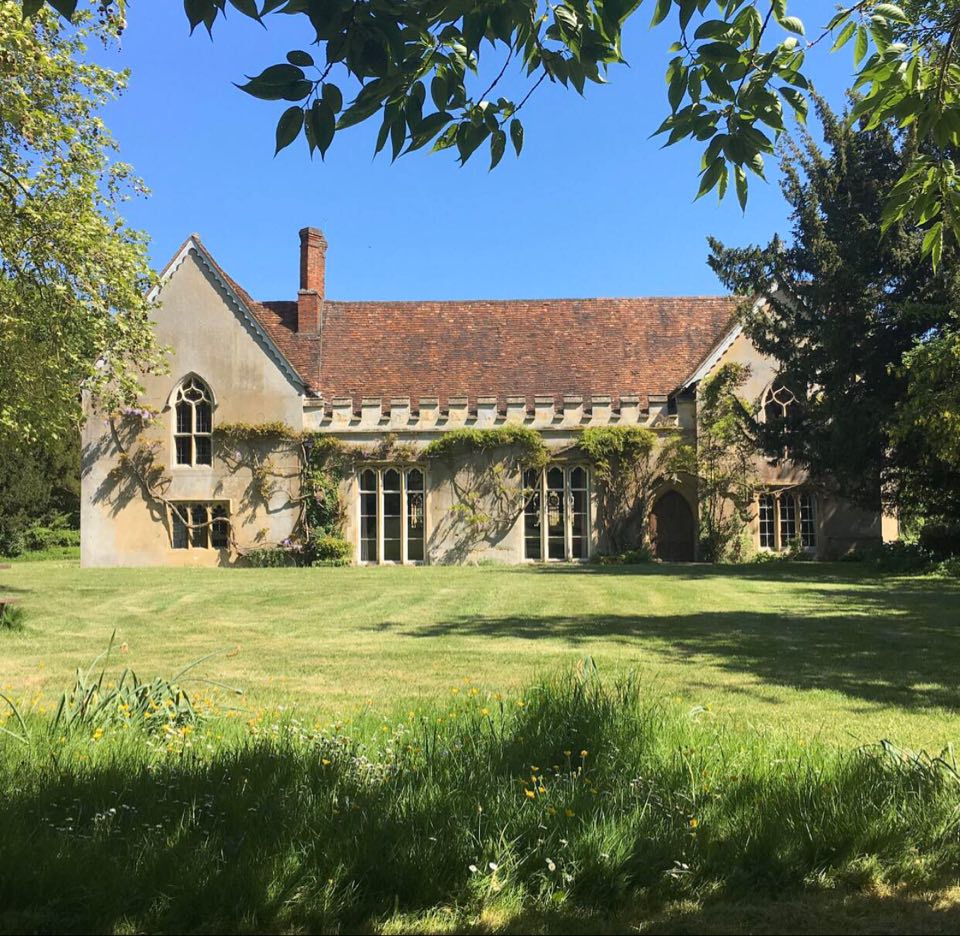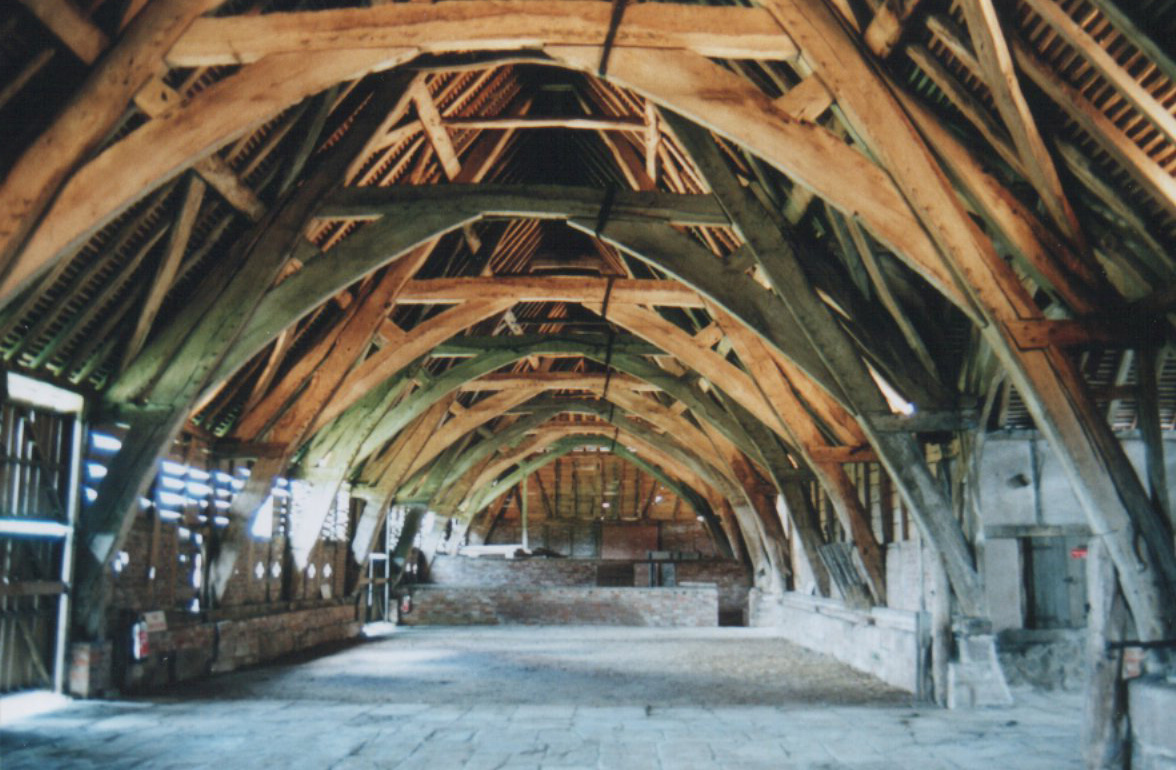|
Manor House (Sutton Courtenay)
The Manor House, Sutton Courtenay, is a Grade II* listed building in the Oxfordshire village, located southwest of the village green and hidden from the main road by trees. It is across the street from The Abbey, Sutton Courtenay, a medieval courtyard house. History and description The south wing of the building is believed to originate from the 13th century, with a 15th-century extension to the east and a north wing dating to about 1670. This creates a U-shaped plan around a courtyard which faces onto a garden leading to the River Thames. The main east wing has five gables and a cruck truss frame. Inside there is a 16th-century arched stone fireplace in the dining room. A late-17th-century dog leg staircase connects the ground floor to the attic. Information from original listing text, 6 August 1952. The south wing has a barrel-vaulted cellar beneath it and a hall and gallery including 15th-century woodwork. From ''A History of the County of Berkshire'' Volume 4 (1924), pages 3 ... [...More Info...] [...Related Items...] OR: [Wikipedia] [Google] [Baidu] |
Sutton Courtenay
Sutton Courtenay is a village and civil parish on the River Thames south of Abingdon-on-Thames and northwest of Didcot. Historically part of Berkshire, it has been administered as part of Oxfordshire since the 1974 boundary changes. The 2011 Census recorded the parish's population as 2,421. Sutton Courtenay is home to some important structures, such as The Abbey, the Manor House, All Saints' Church, a twelfth-century Norman hall, the Sutton Bridge, and Didcot power station. Archaeology and history A Neolithic stone hand axe was found at Sutton Courtenay. Petrological analysis in 1940 identified the stone as epidotised tuff from Stake Pass in the Lake District, to the north. Stone axes from the same source have been found at Abingdon, Alvescot, Kencot and Minster Lovell. Excavations have revealed rough Saxon huts from the early stages of Anglo-Saxon settlement of Britain, but their most important enduring monument in Sutton was the massive causeway and weirs that ... [...More Info...] [...Related Items...] OR: [Wikipedia] [Google] [Baidu] |
Oxfordshire
Oxfordshire is a ceremonial and non-metropolitan county in the north west of South East England. It is a mainly rural county, with its largest settlement being the city of Oxford. The county is a centre of research and development, primarily due to the work of the University of Oxford and several notable science parks. These include the Harwell Science and Innovation Campus and Milton Park, both situated around the towns of Didcot and Abingdon-on-Thames. It is a landlocked county, bordered by six counties: Berkshire to the south, Buckinghamshire to the east, Wiltshire to the south west, Gloucestershire to the west, Warwickshire to the north west, and Northamptonshire to the north east. Oxfordshire is locally governed by Oxfordshire County Council, together with local councils of its five non-metropolitan districts: City of Oxford, Cherwell, South Oxfordshire, Vale of White Horse, and West Oxfordshire. Present-day Oxfordshire spanning the area south of the ... [...More Info...] [...Related Items...] OR: [Wikipedia] [Google] [Baidu] |
The Abbey, Sutton Courtenay
The Abbey in Sutton Courtenay is a medieval courtyard house in the English county of Oxfordshire (formerly Berkshire). It is located in the Vale of White Horse near the River Thames, across the road from the twelfth-century Norman Hall and the Manor House. The Abbey has been recognised as a building of outstanding historic and architectural interest and is considered to be a ‘textbook’ example of an English medieval manor house. It has been a Grade I-listed building since 1952. The Abbey has its origins in the thirteenth century as a rectory of Abingdon Abbey, a Benedictine monastery up north in Abingdon-on-Thames. Several construction phases took place during the Middle Ages, carried out by prominent figures like Solomon of Rochester, Thomas Beckington and William Say, but it wasn't until the seventeenth century that the current plan was completed. It was probably during the Victorian era that the house obtained the name 'The Abbey'. From 1495 to 1867, The Abbey was in ... [...More Info...] [...Related Items...] OR: [Wikipedia] [Google] [Baidu] |
Courtyard House
A courtyard house is a type of house—often a large house—where the main part of the building is disposed around a central courtyard. Many houses that have courtyards are not courtyard houses of the type covered by this article. For example, large houses often have small courtyards surrounded by service rooms or corridors, but the main rooms are not disposed around a courtyard. Blenheim Palace in England is an example of such a house. The main rooms of a courtyard house often open onto the courtyard, and the exterior walls may be windowless and/or semi-fortified and/or surrounded by a moat. Courtyard houses of this type occupy an intermediate position between a castle or fortress, where defence is the primary design consideration, and more modern plans in which defence is not a consideration at all. In England the courtyard house was a popular design for large houses in the sixteenth century, after noblemen had stopped building themselves castles, but before thoughts of defence ... [...More Info...] [...Related Items...] OR: [Wikipedia] [Google] [Baidu] |
River Thames
The River Thames ( ), known alternatively in parts as the River Isis, is a river that flows through southern England including London. At , it is the longest river entirely in England and the second-longest in the United Kingdom, after the River Severn. The river rises at Thames Head in Gloucestershire, and flows into the North Sea near Tilbury, Essex and Gravesend, Kent, via the Thames Estuary. From the west it flows through Oxford (where it is sometimes called the Isis), Reading, Henley-on-Thames and Windsor. The Thames also drains the whole of Greater London. In August 2022, the source of the river moved five miles to beyond Somerford Keynes due to the heatwave in July 2022. The lower reaches of the river are called the Tideway, derived from its long tidal reach up to Teddington Lock. Its tidal section includes most of its London stretch and has a rise and fall of . From Oxford to the Estuary the Thames drops by 55 metres. Running through some of the drier ... [...More Info...] [...Related Items...] OR: [Wikipedia] [Google] [Baidu] |
Gable
A gable is the generally triangular portion of a wall between the edges of intersecting roof pitches. The shape of the gable and how it is detailed depends on the structural system used, which reflects climate, material availability, and aesthetic concerns. The term gable wall or gable end more commonly refers to the entire wall, including the gable and the wall below it. Some types of roof do not have a gable (for example hip roofs do not). One common type of roof with gables, the gable roof, is named after its prominent gables. A parapet made of a series of curves ( Dutch gable) or horizontal steps ( crow-stepped gable) may hide the diagonal lines of the roof. Gable ends of more recent buildings are often treated in the same way as the Classic pediment form. But unlike Classical structures, which operate through trabeation, the gable ends of many buildings are actually bearing-wall structures. Gable style is also used in the design of fabric structures, with varying d ... [...More Info...] [...Related Items...] OR: [Wikipedia] [Google] [Baidu] |
Cruck
A cruck or crook frame is a curved timber, one of a pair, which support the roof of a building, historically used in England and Wales. This type of timber framing consists of long, generally naturally curved, timber members that lean inwards and form the ridge of the roof. These posts are then generally secured by a horizontal beam which then forms an "A" shape. Several of these "crooks" are constructed on the ground and then lifted into position. They are then joined together by either solid walls or cross beams which aid in preventing 'racking' (the action of each individual frame going out of square with the rest of the frame, and thus risking collapse). Etymology The term ''crook'' or ''cruck'' comes from Middle English ', from Old Norse ', meaning "hook". This is also the origin of the word "crooked", meaning bent, twisted or deformed, and also the crook used by shepherds and symbolically by bishops. Use Crucks were chiefly used in the medieval period for structures s ... [...More Info...] [...Related Items...] OR: [Wikipedia] [Google] [Baidu] |
Baron Wantage
Baron is a rank of nobility or title of honour, often hereditary, in various European countries, either current or historical. The female equivalent is baroness. Typically, the title denotes an aristocrat who ranks higher than a lord or knight, but lower than a viscount or count. Often, barons hold their fief – their lands and income – directly from the monarch. Barons are less often the vassals of other nobles. In many kingdoms, they were entitled to wear a smaller form of a crown called a ''coronet''. The term originates from the Latin term , via Old French. The use of the title ''baron'' came to England via the Norman Conquest of 1066, then the Normans brought the title to Scotland and Italy. It later spread to Scandinavian and Slavic lands. Etymology The word '' baron'' comes from the Old French , from a Late Latin "man; servant, soldier, mercenary" (so used in Salic law; Alemannic law has in the same sense). The scholar Isidore of Seville in the 7th century tho ... [...More Info...] [...Related Items...] OR: [Wikipedia] [Google] [Baidu] |
Earl Of Crawford
Earl of Crawford is one of the most ancient extant titles in Great Britain, having been created in the Peerage of Scotland for Sir David Lindsay in 1398. It is the premier earldom recorded on the Union Roll. Early history Sir David Lindsay, who married Elizabeth Stewart, Countess of Crawford, a daughter of Robert II, was the 10th baron of Crawford, Lanarkshire. In 1398 he was given the title of Earl of Crawford, along with Crawford Castle, by Robert. The title descended to the first Earl's descendants without much incident, until the death of David Lindsay, 8th Earl of Crawford, in 1542. The eighth Earl had a son, Alexander, commonly called the ''Wicked Master'', who frequently quarrelled with his father and even tried to murder him. The Wicked Master was sentenced to death for his crime, and the eighth Earl conveyed his title to a cousin, also called David Lindsay, a descendant of the third Earl of Crawford, and excluded from the succession all of the Wicked Master's descend ... [...More Info...] [...Related Items...] OR: [Wikipedia] [Google] [Baidu] |
Norah Lindsay
Norah Mary Madeleine Lindsay (née Bourke) (26 April 1873 – 20 June 1948) was a socialite garden designer who between the World wars became a major influence on garden design and planting in the United Kingdom and on the Continent. Biography Norah Mary Madeline Bourke was born at the hill station of Ootacamund, India into an Anglo-Irish upper class military family, the niece of the 6th Earl of Mayo, the Governor-General and Viceroy of India. At the age of 22 she married the brother of Violet Lindsay Manners, Sir Harry Lindsay and went to live at her wedding gift, Sutton Courtenay Manor, Oxfordshire, actually an assemblage of charming and picturesque houses and cottages, fine barns and stables, where she developed her skills as a gardener. Influenced by Gertrude Jekyll she created the noted garden at the house, with an inspired kind of untidiness that influenced her lifelong friend Vita Sackville-West's love of self-seeded surprise effects within a formal structure at ... [...More Info...] [...Related Items...] OR: [Wikipedia] [Google] [Baidu] |
David Astor
Francis David Langhorne Astor, CH (5 March 1912 – 7 December 2001) was an English newspaper publisher, editor of ''The Observer'' at the height of its circulation and influence, and member of the Astor family, "the landlords of New York". Early life David Astor was born in London, England, the third child of American-born English parents, Waldorf Astor, 2nd Viscount Astor (1879–1952), and Nancy Witcher Langhorne (1879–1964). The product of an immensely wealthy business dynasty, and raised in the grandeur of a great country estate where the political and intellectual elite gathered, he nevertheless showed compassion for the poor and those who were victims of destructive socioeconomic policies. An extremely shy man, David Astor was greatly influenced by his father, but as a young man he rebelled against his strong-willed mother. After an education at West Downs School in Winchester, Hampshire, followed by Eton College in Berkshire, he attended Balliol College, Oxford, wh ... [...More Info...] [...Related Items...] OR: [Wikipedia] [Google] [Baidu] |
Grade II* Listed Buildings In Oxfordshire
The county of Oxfordshire is divided into five districts. The districts of Oxfordshire are Oxford, Cherwell, South Oxfordshire, Vale of White Horse, and West Oxfordshire. As there are 694 Grade II* listed buildings in the county they have been split into separate lists for each district. * Grade II* listed buildings in Cherwell (district) * Grade II* listed buildings in Oxford * Grade II* listed buildings in South Oxfordshire * Grade II* listed buildings in Vale of White Horse * Grade II* listed buildings in West Oxfordshire See also * Grade I listed buildings in Oxfordshire * :Grade II* listed buildings in Oxfordshire ReferencesNational Heritage List for England {{DEFAULTSORT:Grade II listed buildings in Oxfordshire [...More Info...] [...Related Items...] OR: [Wikipedia] [Google] [Baidu] |







.jpg)
